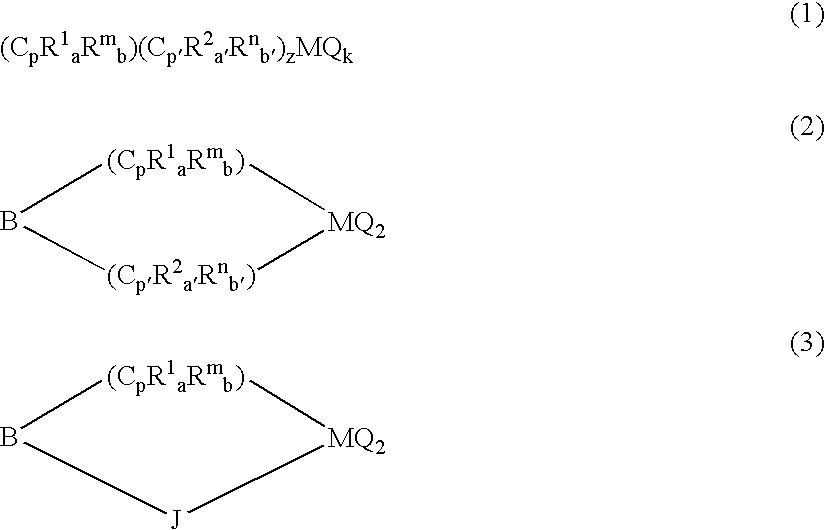Supported metallocene catalyst, method of preparing the catalyst and method of preparing polyolefin using the catalyst
a metallocene catalyst and polyolefin technology, applied in the direction of catalyst activation/preparation, metal/metal-oxide/metal-hydroxide catalyst, etc., can solve the problem of olefin polymerization using a homogeneous catalyst that cannot be used in gas phase process or slurry process, excessive amount of mao is required to maximize, and inducing reactor fouling, etc. problem, to achieve the effect of preventing reactor foul
- Summary
- Abstract
- Description
- Claims
- Application Information
AI Technical Summary
Benefits of technology
Problems solved by technology
Method used
Image
Examples
example 1
1-(1) Preparation of [tBu-O—(CH2)6—C5H4]2ZrCl2(Compound A)
[0085] 100 ml of anhydrous THF was added to t-butoxyhexylchloride (5.87 g, 30.46 mmole) prepared using 6-chlorohexanol according to the method suggested in Tetrahedron Lett. 2951 (1988). 17 ml of 2 N sodium cyclopentadienide (NaCp) was mixed into the resultant mixture in an ice bath, and after 3 hours, 200 ml of water was added to the mixture. Then, the hexane was removed under reduced pressure, 4.2 g of t-butoxyhexylcyclopentadienide (yield 60%, b.p. 80° C. / 0.1 mmHg) was obtained by distillation under reduced pressure (78° C. / 0.2 torr). Subsequently, the resultant product (4.06 g, 18.9 mmol) was dissolved in 20 ml of THF, and then solid n-butyl lithium (1.6 M hexane solution, 11.4 ml) was added to the obtained solution at −78° C. without contacting air. The resultant product was warmed to room temperature and stirred for 2 hours, and then all the volatile materials were removed from the product using a vacuum pump and 20 ml...
example 2
2-(1) Preparation of [tBu-O—(CH2)6(CH3)Si(C5H4)(9—C13H9]ZrCl2(Compound B)
[0090] Grignard reagent, a t-butoxyhexylmagnesium chloride solution (0.14 mol), was obtained by reacting t-butoxyhexylchloride with Mg(O) in the presence of diethyl ether (Et2O) as a solvent. Methyltrichlorisilane (24.7 ml, 0.21 mol) was added to the Grignard reagent at −100° C. and the mixture was stirred at room temperature for at least 3 hours and then filtered. The filtrate was dried in a vacuum to obtain t-butoxyhexyldichloromethylsilane (yield 84%). Then, a solution of fluorenyl lithium (4.82 g, 0.028 mol) in hexane (150 ml) was slowly added to a solution of t-butoxyhexyldichloromethylsilane (7.7 g, 0.028 mol) in hexane (50 ml) at −78° C. for 2 hours. Next, the resultant white precipitate (LiCl) was filtered off and extracted with hexane to obtain the desired product, and then all the volatile materials were removed by drying in a vacuum to obtain t-butoxyhexylfluorenylmethylsilane (tBu-O—(CH2)6)SiMe(9-C...
example 3
3-(1) Preparation of [(CH3)2Si(tBu-O—(CH2)6-(C5H4)(9-C13H9))ZrCl2(Compound C)
[0097] A solution of t-butoxyhexylcyclopentadienyl lithium (0.016 mol; obtained by reacting t-butoxyhexylcyclopentadienide with n-butyl lithium in the presence of THF) was added to a solution of Me2SiCl(9-C13H10) (obtained by reacting fluorenyl lithium with dichlorodimethylsilane in the presence of hexane) in THF (50 ml) at room temperature, and the reaction temperature was slowly raised to room temperature. The mixture was reacted at room temperature for 3 hours, and then all the volatile materials were removed by drying the mixture in a vacuum to obtain an oily liquid. Subsequently, hexane was added to the oily liquid and the mixture was filtered. The filtered hexane solution was dried in a vacuum to obtain a ligand ((CH3)2Si(tBu-O—(CH2)6-(C5H5)(9-C13H10)) as a pale yellow oil (yield 99%). The structure of the ligand was confirmed by 1H NMR.
[0098]1H NMR (400 MHz, C6D6): 1.09(t-BuO, 9H, s), −0.13, −0.32,...
PUM
| Property | Measurement | Unit |
|---|---|---|
| Temperature | aaaaa | aaaaa |
| Digital information | aaaaa | aaaaa |
| Digital information | aaaaa | aaaaa |
Abstract
Description
Claims
Application Information
 Login to View More
Login to View More - R&D
- Intellectual Property
- Life Sciences
- Materials
- Tech Scout
- Unparalleled Data Quality
- Higher Quality Content
- 60% Fewer Hallucinations
Browse by: Latest US Patents, China's latest patents, Technical Efficacy Thesaurus, Application Domain, Technology Topic, Popular Technical Reports.
© 2025 PatSnap. All rights reserved.Legal|Privacy policy|Modern Slavery Act Transparency Statement|Sitemap|About US| Contact US: help@patsnap.com



